Price Check: DDR4 Memory Down Nearly 40% in 6 Months, Expected To Continue
by Anton Shilov on December 18, 2015 8:00 PM EST- Posted in
- DRAM
- Samsung
- Micron
- DDR3
- DDR4
- SK Hynix
- DRAMeXchange
- Price Check
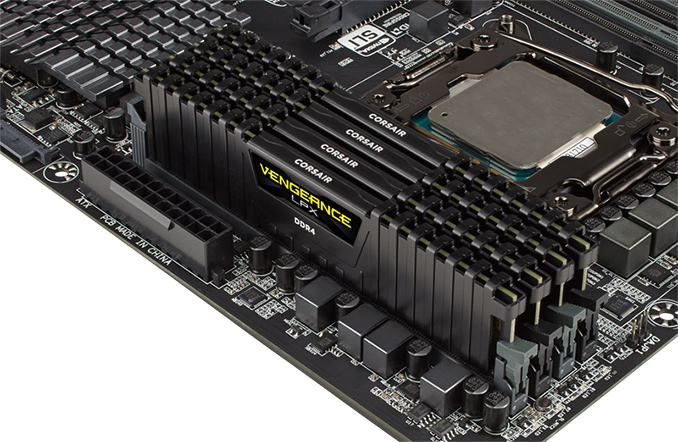
Today we're launching a new feature on the AnandTech Pipeline: Price Check. Here we'll periodically examine hardware prices and analyze what's behind recent price changes.
Just a year ago DDR4 dynamic random access memory (DRAM) was rather expensive and was sold at a noticeable premium compared to DDR3. Today, DDR4 memory modules cost less than DDR3 modules cost a year ago and continue to get more affordable. Next year prices of DDR4 are expected to decline further as manufacturers of DRAM are gradually increasing production of memory in general and DDR4 in particular.
DDR4 Gets Cheaper as Price Premium Over DDR3 Erodes
The average spot price of one 4Gb DDR4 memory chip rated to run at 2133MHz was $2.221 at press time, according to DRAMeXchange, one of the world’s top DRAM and NAND market trackers based in Taipei, Taiwan. Spot price of a similar memory integrated circuit (IC) was $2.719 in late September and $3.618 in late June, 2015. As it turns out, the price of a single 4Gb DDR4 DRAM IC dropped 38.62% in about half of a year.
Spot prices of DDR3 memory are also declining. One 4Gb DDR3 chip rated to operate at 1600MHz cost $1.878 in Taiwan at press time. A similar chip was priced at $2.658 in late June, which means that the spot price of a 4Gb DDR3 IC dropped 29.4% in less than six months.
The difference between a 4Gb DDR3 memory chip and a 4Gb DDR4 DRAM IC used to be approximately 26.5% in June. Today, a 4Gb DDR4 chip costs about 18.5% more than a 4Gb DDR3 memory IC.
Spot prices of DRAM chips directly affect prices of actual memory modules. At present one 4GB DDR4 SO-DIMM costs $18 in Taiwan, according to DRAMeXchange. A DDR3 4GB SO-DIMM is priced at $16.75. For many PC configurations, price difference between DDR3 and DDR4 memory modules is already negligible. Next year it will erode further and the new type of memory will replace DDR3 as the mainstream DRAM for personal computers and servers.
Retail Prices of DDR4 Modules Drop by Over 50% This Year
While spot and contract prices give a good idea about ongoing trends and help to understand the market in general, they do not reveal the retail situation, something that is important for the end user. As it appears, some DDR4 memory kits became over 50% cheaper this year.
Kingston’s HyperX Fury Black 16GB kit (2*8GB) rated to operate at 2133MHz with CL14 latency used to cost $229.20 in March at Amazon.com, according to CamelCamelCamel. Today, the dual-channel kit costs $108.99. Kingston’s HyperX memory modules are relatively affordable solutions for PC enthusiasts, which are used by system integrators too.
G.Skill’s latest Ripjaws V family of memory modules started to show up in retail only in October or November, but they have already got more affordable. Based on checks from CamelCamelCamel, the G.Skill Ripjaws V DDR4 16GB dual-channel kit rated to operate at 3200MHz used to cost $176.64 in early November, but the product is available today for $136.59.
Memory modules for high-end desktop systems tend to get cheaper faster and more significantly than solutions for mainstream PCs. Corsair’s Dominator Platinum 64GB DDR4 quad-channel kit capable of operating at 2666MHz with CL15 latency used to cost up to $1759.99 at Amazon.com early in 2015. By the middle of the year the price of the kit declined to around $1000 and currently the set of four premium 16GB DDR4 memory modules is available for $679.99.
Since the Dominator Platinum series is designed for ultra-high-end systems, it is not surprising that they are generally overpriced. Nonetheless, even such DDR4 memory solutions get more affordable these days.
Supply Exceeds Demand
There are two key reasons why computer memory is getting more affordable. Firstly, demand for DRAM is not high these days. Secondly, makers of memory chips are transiting to thinner process technologies, effectively increasing their output. Since supply exceeds demand, prices are getting lower.
Sales of personal computers as well as tablets dropped this year, which decreased demand for DRAM by the industry. According to International Data Corp. (IDC), shipments of PCs in the third quarter of 2015 totaled 71 million units, a 10.8% decline from the same period a year ago, but a 7.4% increase from the second quarter of 2015. Sales of tablets in Q3 2015 reached 48.7 million units, which is 12.6% less than in Q3 2014, but 8.94% more than in Q2 2015. By contrast, the industry shipped 355.2 million smartphones in the third quarter, up 6.8% year-over-year and 5.3% sequentially.
The vast majority of personal computers and many tablets use commodity DDR3 or DDR4 memory, whereas contemporary smartphones use LPDDR3 or LPDDR4 memory. Typically, when demand for PCs and commodity DRAM drops, memory makers start to increase output of more expensive server DRAM as well as LPDDR memory to offset revenue declines. According to DRAMeXchange, 40% of global DRAM bit output was LPDDR in Q3 2015.
Modest growth of smartphone sales amid declines of PCs and tablets in the third quarter barely helped DRAM makers to maintain their revenue at approximately the same level as in the second quarter. Global DRAM revenue in Q3 2015 totaled $11.298 billion, down 1.2% from Q2 2015, DRAMeXchange found.
DRAM Prices to Keep Declining
While there are only three major makers of DRAM left on the planet, they continue to fight for market share and profits. In a bid to cut-down costs, manufacturers of memory have to adopt thinner process technologies, which decreases sizes of memory cells and thus increases bit output per wafer. As a result, global supply of DRAM upsurges and affects prices.
This year Samsung Electronics continued its transition to 20nm DRAM manufacturing technology, whereas its rivals — Micron Technology and SK Hynix — only started to use their 20nm and 21nm fabrication processes. The thinner production technology helped Samsung to increase its profit margins and market share. The company controlled 46.7% of the DRAM market in Q3 2015, up from 45.1% in the second quarter. SK Hynix and Micron commanded 28% and 19.2% of the memory market, respectively, according to the market tracker.
Analysts from DRAMeXchange believe that transition to 20nm/21nm manufacturing technologies, slow economy and weak demand for electronics will negatively affect prices of DRAM going forward as supply will exceed demand. To stay profitable, DRAM makers will have to migrate to thinner fabrication processes faster and balance their product mixes.
“Looking ahead to next year’s DRAM market, the annual demand and supply bit growth rates are projected around 23% and 25% respectively,” said to Avril Wu, research director of DRAMeXchange. “Supply will still outpace demand by bit and average sales prices will continue to drop. Whether suppliers can turn a profit will mainly depend on their progression in technology migration and product-mix strategies.”
One good news for DRAM makers is that 20nm and 21nm process technologies help to reduce costs of DDR4 ICs in general and 8Gb DDR4 memory chips in particular. Such DRAM ICs are required to build high-capacity — 32GB, 64GB, 128GB — memory modules. Such products are sold at a considerable premium to server makers, which helps to bolster revenue and profits of memory producers.


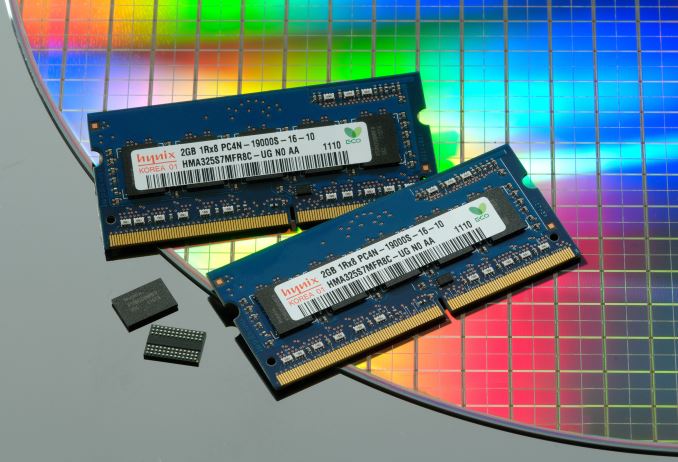
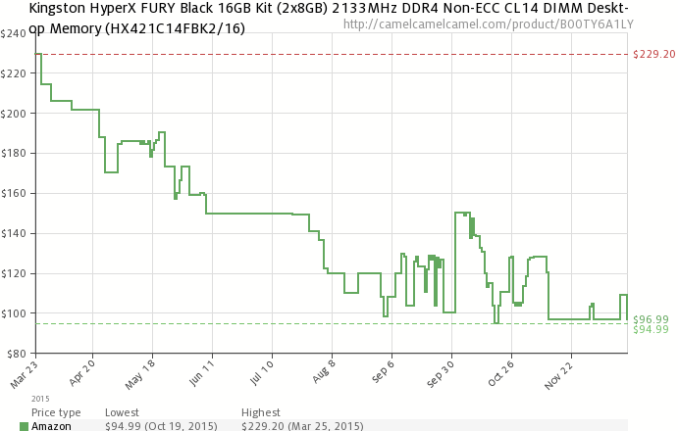
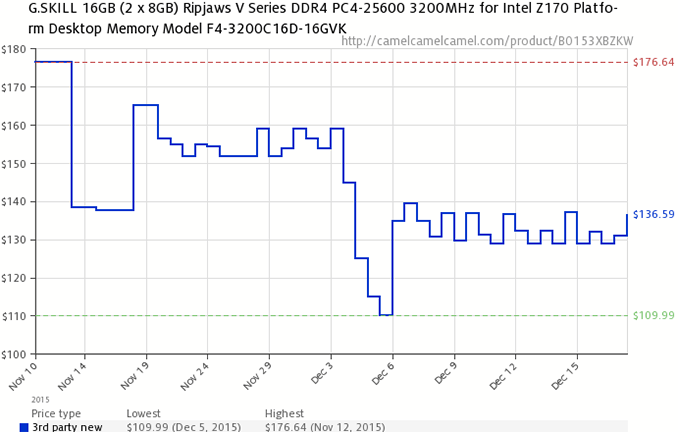

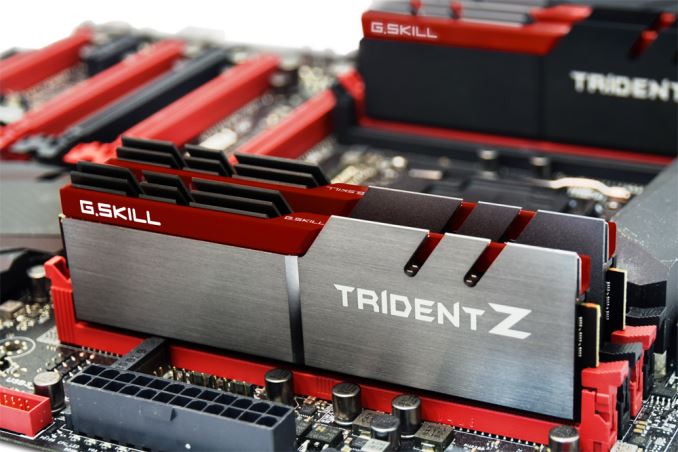

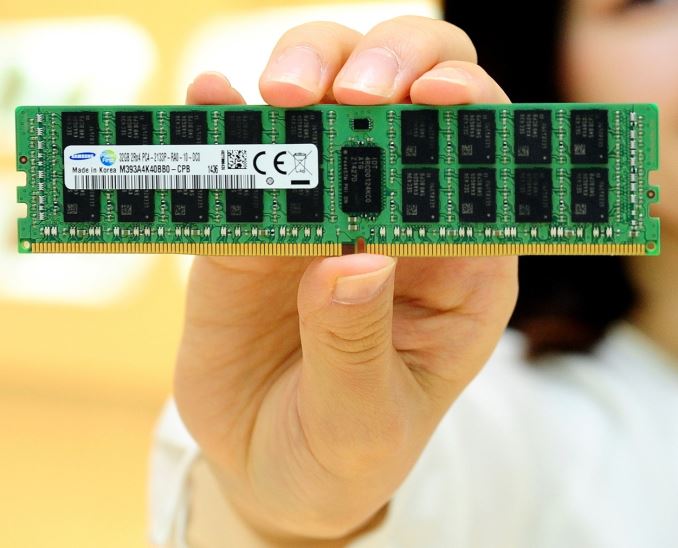








33 Comments
View All Comments
Murloc - Saturday, December 19, 2015 - link
yeah price checks like these are definitely going to be useful content.sonicmerlin - Saturday, December 19, 2015 - link
Next can you do a feature on HDD prices, and how they're essentially the same $/GB as they were in 2011?azazel1024 - Monday, December 21, 2015 - link
If you mean the highest capacities, that might be more or less true in $/GB. However, back roughly in 2011 I had gotten some Samsung 2TB drives for about $100 a pop (2 of them over the course of about 10 months, starting in I think 2010 and the last one was a 2011 purchase). IIRC I got one for $100 and the other one was $90. A bit less than a year ago I snapped up 4, 3TB drives for $90 for the most expensive one, 2 for $65 and 1 for $60. Yes, all of them where on sale or Amazon warehouse deals...but both of those Samsung 2TB drives were also on sale at the time. Sure, the $/GB isn't many times over lower after 4-5 years, but it still was roughly half the price per GB.SSDs, now those are tumbling like crazy. Might actually surpass HDDs in another 4-6 years. Won't be sad if that happens.
jasonelmore - Saturday, December 19, 2015 - link
I think a lot of this "Supply Exceeding Demand" has to do with Intel's 6700K CPU just not being available.It has been 4 months since release, and you still cant buy one at MSRP. Intel is devoting 90% of their 14nm Fab's to Dual Core Mobile chips. Big mistake
They already admitted they made a mistake by ignoring the Broadwell Desktop Market, and also admitted to losing several million dollars because of that decision.
But they did not learn, because they make the same mistake again with Skylake and devoted almost their entire 14nm fab capacity to mobile chips, instead of desktop chips.
VR, 4K, and the PC Masterrace Uprising has drove Desktop PC components to new highs, but nobody can get the K varient Parts they want.
Intel, Listen man, Learn from your mistake... you gotta treat the desktop space with more respect. Don't listen to market analyst, the PC Desktop market is trying to explode, but your not letting it.
Michael Bay - Saturday, December 19, 2015 - link
Intel doesn`t care about a few measly millions, and neither does it care about basement overclockers that don`t make one percent of the market all put in one basement.Money is in mobile right now, and that`s where Intel will go.
patrickjp93 - Saturday, December 19, 2015 - link
Most of its 14nm capacity is actual Broadwell E, EP, and Knight's Landing right now, and those are all much higher-margin products than the 6700K, which actually I bought for $320 in late October, just above MSRP, right where they always end up.BMNify - Saturday, December 19, 2015 - link
Price Check is a Nice feature, hope you will cover loads of computer parts and even accessories like Wifi routers etc in this.svan1971 - Saturday, December 19, 2015 - link
I'll wait for 3000 cas 9patrickjp93 - Saturday, December 19, 2015 - link
It will never happen, and nor should it matter since the bus latency went down by more than 10 nanoseconds vs. the 2 added by higher CAS in DDR4.Galcobar - Saturday, December 19, 2015 - link
When dealing with a commodity largely produced in Asia, information on the effect of the much stronger US dollar would be helpful.